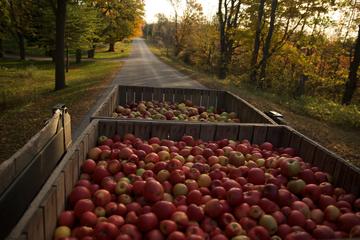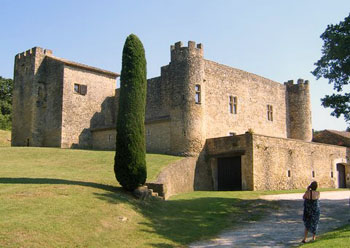
Southern France
by Chris and Rick Millikan
For many years, we dreamed of escaping to sun-drenched Provence and recently fulfill this fantasy. And our stay at Chateau de Boussargues proves the perfect ‘base camp’ for launching journeys back in time in southern France.
“The Romans first grew grapes here – and not long afterward, Christians built that little stone chapel in the woods,” owner Olivier tells us. As we survey its surrounding estate vineyards he continues, “And in the 12th century, Templar Knights began replacing earlier fortifications with our present castle.”
Crossing the bricked patio to a stone cottage, he points out aged trees, “Those Mulberry leaves fed silkworms once grown inside – and much later it became a shepherd’s dwelling.” Thick oak door unlocked, he shows us inside – an idyllic setting for history buffs like us.
As we wind through the Rhone Valley’s iconic rolling green landscapes on a different day trip each day. Picturesque country roads carry us past countless vineyards, cypress hedged orchards, small farms and into several charming villages.
 Medieval Fontaine-de-Vaucluse nestles among chalky cliffs to the east. After strolling to its renowned spring, the largest in France, we savor luscious crepes at an open-air bistro overlooking its emerald stream. From picture-perfect Gordes, a white stone village clustered atop a hilltop, we hike the rugged trail to enchanting Abbey of Sénanque, set among perfumed lavender fields and golden wheat that undulate in warm breezes. And inside walled Pernes-les-Fontaines, a self-guided walking map guides us to many of its forty treasured fountains.
Medieval Fontaine-de-Vaucluse nestles among chalky cliffs to the east. After strolling to its renowned spring, the largest in France, we savor luscious crepes at an open-air bistro overlooking its emerald stream. From picture-perfect Gordes, a white stone village clustered atop a hilltop, we hike the rugged trail to enchanting Abbey of Sénanque, set among perfumed lavender fields and golden wheat that undulate in warm breezes. And inside walled Pernes-les-Fontaines, a self-guided walking map guides us to many of its forty treasured fountains.
Massive weathered ramparts still encircle Avignon. Passing through the main gate, we follow Rue de la Republic to feast on neoclassical architecture in Place du Horloge in the heart of old town. Then just along a narrow street in a huge nearby square we sight a golden Virgin Mary soaring above Cathedral Notre-Dame-des-Dom’s elaborate angelic marble statuary. And next door, Europe’s largest Gothic palace awaits us.
 Entering the Palais des Papes through enormous portals, we meander through its arched courtyards and into halls with vaulted ceilings, huge treasury rooms and even the colossal kitchen tower. Exhibits and illustrated storyboards explain how in 1309, Pope Clement V escaped the turbulence of Rome to reside in Avignon. A subsequent pope bought Avignon from Queen Joanna I of Sicily for 80,000 gold gulden. And over a span of 68 years, this vast fortified religious fortress protected and pampered seven consecutive popes until the papacy officially returned to Rome.
Entering the Palais des Papes through enormous portals, we meander through its arched courtyards and into halls with vaulted ceilings, huge treasury rooms and even the colossal kitchen tower. Exhibits and illustrated storyboards explain how in 1309, Pope Clement V escaped the turbulence of Rome to reside in Avignon. A subsequent pope bought Avignon from Queen Joanna I of Sicily for 80,000 gold gulden. And over a span of 68 years, this vast fortified religious fortress protected and pampered seven consecutive popes until the papacy officially returned to Rome.
A maze of now-bare rooms reflect clues to their sumptuous lifestyles: original ornate tiles floor the meditation alcove; lively frescoes of hunting scenes surround an early pope’s bedchamber and compelling paintings of Christ’s life remain in a small chapel. From dining hall windows, we visualize the lush, once-extensive vegetable gardens and exotic papal menagerie filling arched courtyards below. Sweeping views from the ramparts include Le Petit Palais, a restored archbishop’s palace across the square featuring superb Renaissance Italian art.
Rising high above the palace, Rocher-de-Dom’s rocky hilltop park offers us vibrant gardens, shady pathways and classic statuary. From those stone bluffs, we can gaze down at the once-raging Rhone River, today tamed by hydroelectric dams and sight St. Benezet Bridge aka Pont d’Avignon, the city’s most celebrated monument.
 Delighting in cool breezes off the Rhone, we later approach this bridge. Humming the catchy children’s song immortalizing St. Benezet’s bridge, we zanily sing, “Sur le pont d’Avignon, l’on y danse, l’on y danse,” over and over. Circling round and round, we dance our way across the remains of this fabled structure…to the amusement of others strolling there.
Delighting in cool breezes off the Rhone, we later approach this bridge. Humming the catchy children’s song immortalizing St. Benezet’s bridge, we zanily sing, “Sur le pont d’Avignon, l’on y danse, l’on y danse,” over and over. Circling round and round, we dance our way across the remains of this fabled structure…to the amusement of others strolling there.
Originally 947 meters long, four meters wide with 22 wooden arches, this strategically placed bridge had attracted travelers and merchants from far and wide during the middle ages. Being the sole bridge between Lyon and the Mediterranean, both Avignon and the church prospered greatly from its heavy tolls and taxes on merchandise.
We pause at the two-story chapel precariously perched on the first of four surviving arches. Above, tiny 13th century Chapelle Saint Nicholas, devoted patron saint of Rhone bargemen; below, 12th century Chapelle Saint Benezet honouring the shepherd-saint inspired by holy voices to build ‘le pont’ at Avignon. According to legend, heavenly angels guided the young shepherd to Avignon. Though his proposal first provoked ridicule, he convinced wealthy supporters of the ‘divine will’ by lifting a huge boulder and heaving it down at the designated site. Sadly, Benezet never witnessed this miraculous project’s completion in 1185.
Reaching the furthest span we survey Villeneuve-les-Avignon on the opposite riverbank, at one-time a glittering sister-city of cardinals. This charming medieval village boasts marvelous 14th century structures of its own…
 Along many others, we stream back along this angel-inspired bridge and imagine those alluring bygone days. We then thread our way down cobbled streets to other shaded plazas and discover venerable cathedrals displaying resplendent artistry including refurbished mansions serving as fine art museums. Lingering in open-air bistros over buttery croissants thick with local cheeses and pungent lattes, we contemplate the extravagances of Avignon’s past glory days.
Along many others, we stream back along this angel-inspired bridge and imagine those alluring bygone days. We then thread our way down cobbled streets to other shaded plazas and discover venerable cathedrals displaying resplendent artistry including refurbished mansions serving as fine art museums. Lingering in open-air bistros over buttery croissants thick with local cheeses and pungent lattes, we contemplate the extravagances of Avignon’s past glory days.
Also a World Heritage site, Arles was established as a major Roman port and also became home to impressionist artists. Following her winding, narrow streets marked with theme plaques of Antique, Medieval, Renaissance and Van Gogh routes, we discover her most prestigious monuments.
The Roman coliseum still crowns Arles’ north hillside. From 90AD, 20,000 spectators sat on 34 rows of stone steps, wildly cheering chariot races…and later slaves, criminals and wild animals fighting for their lives on the wooden stage below. These days, citizens flock to this remarkable oval for summer bullfights, popular since1830.
Basking in the top tier’s cooling breezes, we scan three of four towers fortifying the arena during the turbulent Middle Ages and across red-tiled rooftops sight the Roman theater, our next stop. Now an outdoor cinema and concert venue, this ancient theatre seated 10,000 patrons. Only two of many elaborately carved statues and marble columns adorning its stage remain, fondly nicknamed ‘the two widows.’
A lone flautist fills nearby Place de la Republic with haunting melodies. Amid this busy square an Egyptian obelisk rises 15 meters from a fountain; the chateau-style 17th century town hall boasts a 1553 bell-tower. Most striking, Saint-Trophime Cathedral features an elaborate façade of sculpted biblical scenes, apostles, saints and two beatific angels crowning Saint-Trophime himself, the 2nd century bishop who brought Christianity to this region.
Resting on wooden pews inside, we immerse in the cool serenity. Sunlight streams through stained glass windows, splashing reds, yellows and blues onto the austere stone interior. A sweet, heavenly voice soon lures us into an adjacent courtyard outside. On a shaded stage among medieval carvings and marble columns, a young opera singer polishes stirring arias for her evening concert. Wistful notes circle these hallowed cloisters and follow us onward to Place du Forum.
 Mature plane trees shade the ancient forum, today bustling with shops, hotels and bistros, including Le Cafe la Nuit depicted by Van Gogh in Cafe Terrace at Night. The brilliant yellow walls, awnings and tablecloths recreate this acclaimed impressionist’s luminous effect of shimmering evening lights. Sipping café-au-lait and munching flaky-fresh croissants there, we notice a chunk of the original Roman Forum in the façade of Nord-Pinus Hotel across the way. And just off the square, Hotel d’Arlatan incorporates thick walls from Emperor Constantine’s extravagant royal residence.
Mature plane trees shade the ancient forum, today bustling with shops, hotels and bistros, including Le Cafe la Nuit depicted by Van Gogh in Cafe Terrace at Night. The brilliant yellow walls, awnings and tablecloths recreate this acclaimed impressionist’s luminous effect of shimmering evening lights. Sipping café-au-lait and munching flaky-fresh croissants there, we notice a chunk of the original Roman Forum in the façade of Nord-Pinus Hotel across the way. And just off the square, Hotel d’Arlatan incorporates thick walls from Emperor Constantine’s extravagant royal residence.
Returning to our car on a quiet walkway along the Rhone, we pass the Thermae of Constantine, reminding us that the Emperor’s palace had stretched far along the riverfront. His immense brick bathhouse barely hints at the opulence bathers then enjoyed.
Back at our magical lodgings, we do some lavish bathing of our own. Blissfully afloat in the castle’s pool, we try to imagine what Constantine and those stern Templar Knights might think of today’s luxurious world. Dining later under the stars with friends, we raise goblets filled with robust wines from the chateau’s time-honored cellars and toast the wonders of Southern France.
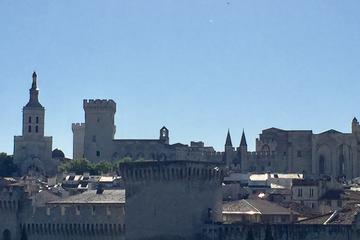
Avignon Private Tour : The Papal City
If You Go:
– For a good overview
– For car rentals
– For rail service possibilities
– For heritage villas, cottages or hotels
– For cheap flights to Paris
About the author:
much-traveled freelance writer/photographer team living near Vancouver, BC, Chris & Rick Millikan are former educators who now present the joys of travel as an inviting ‘curriculum.’ BC community newspapers regularly publish their travel stories…and occasionally In-flight Magazines, the Vancouver Sun and Province. Both are members in good standing of the British Columbia Association of Travel Writers (www.bctravelwriters.com). Chris is the Board’s Vice President. Often reflecting zany, cultural and historic adventures, their accounts of off the beaten track adventures are featured regularly in Senior Living Magazine (www.seniorlivingmag.com) and Open Road Driver Magazine (www.openroaddriver.com) The 2009 Kalama Award acknowledges this team’s array of stories reflecting the rich culture of Maui, Molokai and Lanai. As contributing writers for www.travelwriterstales.com their tales are syndicated in newspapers throughout BC. Contact: Chris at chrsmillikan4@gmail.com & Rick at millikan@axion.net
All photographs by Rick & Chris Millikan.

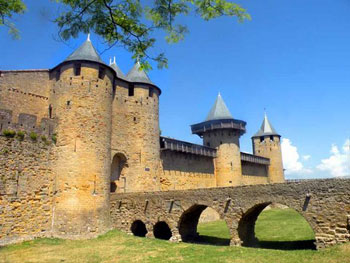
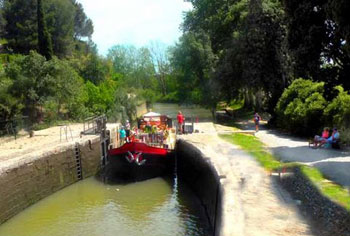 The captain and deckhand swiftly dismantle the roof and windows of our boat’s raised wheelhouse as an ancient stone bridge comes into view. We crouch and duck our heads; the vessel just barely fits underneath. Beyond, the boat slips serenely along on a ribbon of green under a shady canopy of plane trees. At the occasional break in the foliage, we spot a tall church spire, sprawling vineyards and the distant snowy peaks of the Pyrenees. Our captain will not need to replace the wheelhouse for days to come. It is May, and the weather remains blissfully warm and dry. Welcome to the Canal du Midi, which crosses Languedoc in the sunny South of France.
The captain and deckhand swiftly dismantle the roof and windows of our boat’s raised wheelhouse as an ancient stone bridge comes into view. We crouch and duck our heads; the vessel just barely fits underneath. Beyond, the boat slips serenely along on a ribbon of green under a shady canopy of plane trees. At the occasional break in the foliage, we spot a tall church spire, sprawling vineyards and the distant snowy peaks of the Pyrenees. Our captain will not need to replace the wheelhouse for days to come. It is May, and the weather remains blissfully warm and dry. Welcome to the Canal du Midi, which crosses Languedoc in the sunny South of France.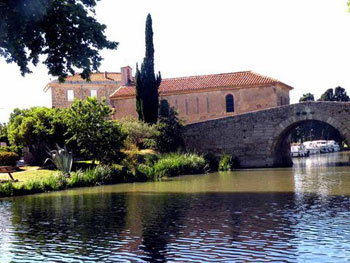 We arrive in the town of Beziers on the 330th anniversary of the canal’s official opening. Gala concerts, sound and light shows, and fireworks mark the event. With narrow cobblestone streets, a beautiful hillside park, and inviting little outdoor restaurants, Beziers is the birthplace of Pierre-Paul Riquet, the genius who conceived and spearheaded the 150-mile long canal project, beginning in the 1660s. The goal was to link the Atlantic with the Mediterranean, thereby avoiding the dangerous journey around Spain and past the fierce Barbary pirates. Its design is unlike most other canals, in France and elsewhere, which are excavated trenches that generally follow natural river valleys and draw their water supply from those rivers. The Canal du Midi follows the contours of hillsides and crosses right over natural features like rivers and streams on the raised archways of elegant stone aqueducts. Its source of water is a large mountain reservoir. Near Beziers, the canal leaps up a steep stone “staircase” of nine consecutive locks and later tunnels through a low mountain. A 17th century engineering marvel.
We arrive in the town of Beziers on the 330th anniversary of the canal’s official opening. Gala concerts, sound and light shows, and fireworks mark the event. With narrow cobblestone streets, a beautiful hillside park, and inviting little outdoor restaurants, Beziers is the birthplace of Pierre-Paul Riquet, the genius who conceived and spearheaded the 150-mile long canal project, beginning in the 1660s. The goal was to link the Atlantic with the Mediterranean, thereby avoiding the dangerous journey around Spain and past the fierce Barbary pirates. Its design is unlike most other canals, in France and elsewhere, which are excavated trenches that generally follow natural river valleys and draw their water supply from those rivers. The Canal du Midi follows the contours of hillsides and crosses right over natural features like rivers and streams on the raised archways of elegant stone aqueducts. Its source of water is a large mountain reservoir. Near Beziers, the canal leaps up a steep stone “staircase” of nine consecutive locks and later tunnels through a low mountain. A 17th century engineering marvel.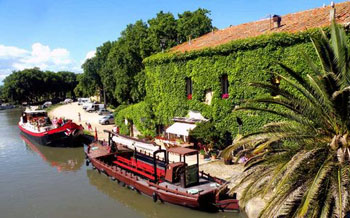 Captain Uli Weber picks us up at our hotel, along with our Australian companions Jan Kenchington and Janette Frost, and drives us west out of Beziers to join Caroline, which we have booked through FranceCruises.com. Built in the 1920s as a classic Dutch sailing barge, the boat is brightly painted with graceful hull lines, upswept both fore and aft, and a broad, spacious main deck. We are greeted by Uli’s wife Ute, who takes us below and shows us to our well-appointed cabins.
Captain Uli Weber picks us up at our hotel, along with our Australian companions Jan Kenchington and Janette Frost, and drives us west out of Beziers to join Caroline, which we have booked through FranceCruises.com. Built in the 1920s as a classic Dutch sailing barge, the boat is brightly painted with graceful hull lines, upswept both fore and aft, and a broad, spacious main deck. We are greeted by Uli’s wife Ute, who takes us below and shows us to our well-appointed cabins.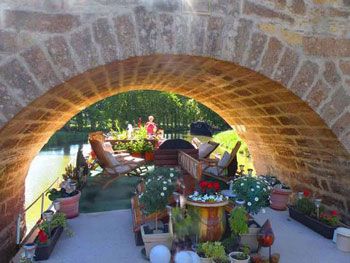 Caroline, however, is a much smaller and more intimate boat. Uli and Ute are the owners. They live aboard year-round and do everything themselves, which allows them to charge considerably less. He pilots the barge, is waiter at mealtimes, and serves as driver and highly knowledgeable guide during side trips in their mini-van. She is the five-star chef, with 250 cookbooks in her collection, as well as chambermaid and deckhand while docking or going through locks. From the first moments, we feel ourselves to be guests in a lovingly decorated home. It is an informal space that is planted with on-deck flower beds and studded with cushioned deck chairs, zany wooden sculptures, even a tiny pond full of fishes and water lilies. Although there is a cozy salon below, with a dining table, sofas and a wood-burning fireplace, we are favoured by good weather and take most meals up on deck.
Caroline, however, is a much smaller and more intimate boat. Uli and Ute are the owners. They live aboard year-round and do everything themselves, which allows them to charge considerably less. He pilots the barge, is waiter at mealtimes, and serves as driver and highly knowledgeable guide during side trips in their mini-van. She is the five-star chef, with 250 cookbooks in her collection, as well as chambermaid and deckhand while docking or going through locks. From the first moments, we feel ourselves to be guests in a lovingly decorated home. It is an informal space that is planted with on-deck flower beds and studded with cushioned deck chairs, zany wooden sculptures, even a tiny pond full of fishes and water lilies. Although there is a cozy salon below, with a dining table, sofas and a wood-burning fireplace, we are favoured by good weather and take most meals up on deck.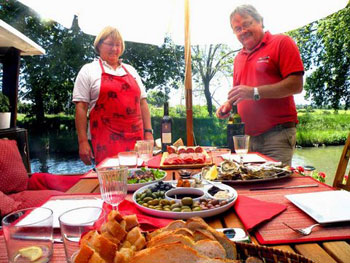 For guests who prefer to sample the many interesting canal-side eateries, the Caroline cruises offer a lower priced half-board option. Guests take breakfast and a large lunch on board but eat most dinners in nearby restaurants at their own expense. We do this one night and enjoy an excellent dinner with wine at a classic auberge within easy staggering distance of the moored barge. Another variation is to have lunch in a market restaurant during a side trip, or to select and bring back the fixings for a picnic lunch or a barbecue on board the boat. Uli and Ute are flexible and open to all suggestions. One side trip takes us to the morning market in a nearby town, where Uli invites us to select anything we want him to purchase for our lunch. There are at least 25 kinds of olives, prepared in different ways, and an amazing assortment of cheeses and dry salamis, with each vendor offering taste tests. I am eager to try the Mediterranean oysters, and Uli knows just who has the best shellfish. Back on board, Ute serves me half of them raw, and they are the freshest and most succulent I have ever eaten. The rest she grills lightly with Parmesan cheese and parsley for the others to taste. They are sublime.
For guests who prefer to sample the many interesting canal-side eateries, the Caroline cruises offer a lower priced half-board option. Guests take breakfast and a large lunch on board but eat most dinners in nearby restaurants at their own expense. We do this one night and enjoy an excellent dinner with wine at a classic auberge within easy staggering distance of the moored barge. Another variation is to have lunch in a market restaurant during a side trip, or to select and bring back the fixings for a picnic lunch or a barbecue on board the boat. Uli and Ute are flexible and open to all suggestions. One side trip takes us to the morning market in a nearby town, where Uli invites us to select anything we want him to purchase for our lunch. There are at least 25 kinds of olives, prepared in different ways, and an amazing assortment of cheeses and dry salamis, with each vendor offering taste tests. I am eager to try the Mediterranean oysters, and Uli knows just who has the best shellfish. Back on board, Ute serves me half of them raw, and they are the freshest and most succulent I have ever eaten. The rest she grills lightly with Parmesan cheese and parsley for the others to taste. They are sublime.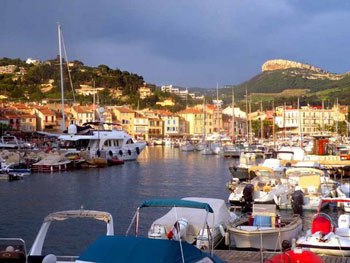 Most side trips, however, are focused on more than food. Languedoc is rich in historical sites. In Narbonne, we view a small excavated section of the Via Domitia, the ancient road that linked Rome with Spain. Hannibal probably passed this way with his elephants to attack Rome in 218 B.C. We tour the fortified hilltop village of Minerve. A little museum with dioramas tells the grim tale of how the redoubt was besieged and captured in 1210 during a papal crusade against the region’s heretical Cathar Christians. Nearly everyone, including women and children, was slaughtered in the fighting or burned at the stake afterwards. Uli drives us to a hilltop to view a huge, strangely symmetrical depression in the land that stands out even from Earth orbit. It marks where a lake was drained around 1200 to eradicate mosquitoes. Local monks did this by digging a precise pie-shaped network of ditches that converge at the centre of an enormous circle, now planted in orchards and grape vines.
Most side trips, however, are focused on more than food. Languedoc is rich in historical sites. In Narbonne, we view a small excavated section of the Via Domitia, the ancient road that linked Rome with Spain. Hannibal probably passed this way with his elephants to attack Rome in 218 B.C. We tour the fortified hilltop village of Minerve. A little museum with dioramas tells the grim tale of how the redoubt was besieged and captured in 1210 during a papal crusade against the region’s heretical Cathar Christians. Nearly everyone, including women and children, was slaughtered in the fighting or burned at the stake afterwards. Uli drives us to a hilltop to view a huge, strangely symmetrical depression in the land that stands out even from Earth orbit. It marks where a lake was drained around 1200 to eradicate mosquitoes. Local monks did this by digging a precise pie-shaped network of ditches that converge at the centre of an enormous circle, now planted in orchards and grape vines.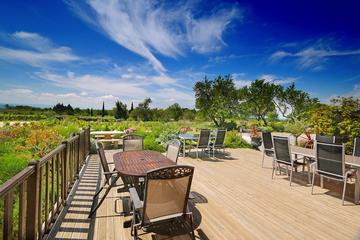
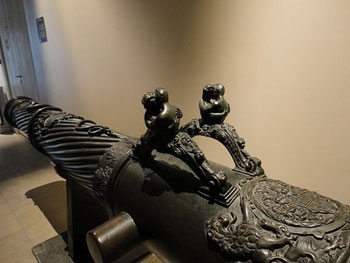

 When we went to Notre Dame, I was delighted to find the Hotel Dieu next door. Why? This was one of the first hospitals built in Europe, in 622 AD. I assumed not many travelers knew it was a hospital and passed by thinking it was a hotel. (It says, “Hotel Dieu” at the entrance and is decorated with international flags.) The present building was not the one from 622 AD, as that original one was burned down in the 1700s. The one we see today was built in 1822. Why is it still called a hotel? In French, it translates to Hostel of God. The first European hospitals during the Middle Ages were managed by the clergy. Their purpose initially was not to treat the sick but to serve as lodging to travelers.
When we went to Notre Dame, I was delighted to find the Hotel Dieu next door. Why? This was one of the first hospitals built in Europe, in 622 AD. I assumed not many travelers knew it was a hospital and passed by thinking it was a hotel. (It says, “Hotel Dieu” at the entrance and is decorated with international flags.) The present building was not the one from 622 AD, as that original one was burned down in the 1700s. The one we see today was built in 1822. Why is it still called a hotel? In French, it translates to Hostel of God. The first European hospitals during the Middle Ages were managed by the clergy. Their purpose initially was not to treat the sick but to serve as lodging to travelers.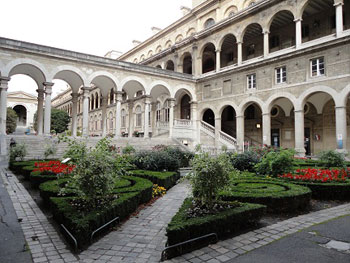 This military museum houses historical artifacts of armour, artillery, and various weapons through French history. Napoleon’s Tomb is situated at one end where you have to leave the museum building to walk to the building’s tomb. We were certainly not military experts nor were we that interested in the museum (as we had planned on just going to Napoleon’s Tomb at the end of the tour), but a couple of amusing gems popped up here. We saw hundreds of knit armor and noticed some really small ones that would fit a child. Did children have to participate in the wars as well? Child labor laws did only appear recently in time! After passing by several cannons on our way to the tomb, we found a cannon with figures of two pairs of kissing couples [TOP PHOTO]. We could not find any history panels to explain its origin. Did the cannon makers have a sense of humor to make love and not war?
This military museum houses historical artifacts of armour, artillery, and various weapons through French history. Napoleon’s Tomb is situated at one end where you have to leave the museum building to walk to the building’s tomb. We were certainly not military experts nor were we that interested in the museum (as we had planned on just going to Napoleon’s Tomb at the end of the tour), but a couple of amusing gems popped up here. We saw hundreds of knit armor and noticed some really small ones that would fit a child. Did children have to participate in the wars as well? Child labor laws did only appear recently in time! After passing by several cannons on our way to the tomb, we found a cannon with figures of two pairs of kissing couples [TOP PHOTO]. We could not find any history panels to explain its origin. Did the cannon makers have a sense of humor to make love and not war?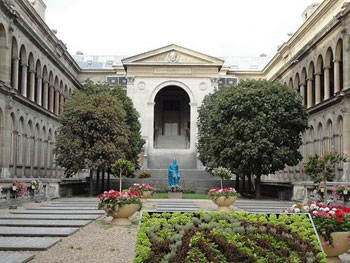 The Rodin Museum houses the famed sculptor’s best works; he requested the government to establish a museum for his artwork. But what you might have known is that Rodin’s mistress, sculptor Camille Claudel, also has a collection here. Rodin and Claudel had a fiery on-and-off relationship; she once accused him of stealing her sculpting ideas. After Rodin left her to return to Rose Beuret, his longtime companion and mother of his son, Claudel spiraled into mental illness, living in a mental institution the last years of her life. Rodin, perhaps having a soft heart and appreciating her talents, requested Claudel’s works to be showcased in his museum.
The Rodin Museum houses the famed sculptor’s best works; he requested the government to establish a museum for his artwork. But what you might have known is that Rodin’s mistress, sculptor Camille Claudel, also has a collection here. Rodin and Claudel had a fiery on-and-off relationship; she once accused him of stealing her sculpting ideas. After Rodin left her to return to Rose Beuret, his longtime companion and mother of his son, Claudel spiraled into mental illness, living in a mental institution the last years of her life. Rodin, perhaps having a soft heart and appreciating her talents, requested Claudel’s works to be showcased in his museum.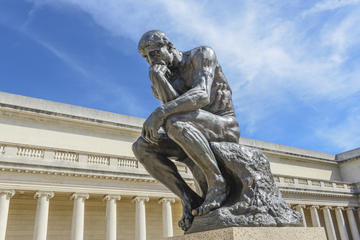
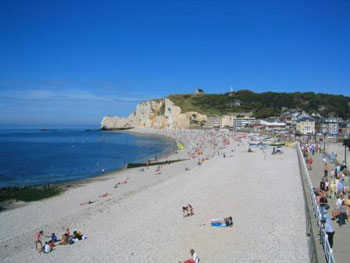
 The chalky north coast of Normandy captures the heart of every visitor at first sight. Years of seawater erosion and weathering have sculpted the coastline on both the west and east sides of the beach, leaving behind towering white cliffs and protruding headlands pierced by arches of various sizes. No wonder Monet visited Étretat every year between 1883 and 1886 and produced more than 60 paintings.
The chalky north coast of Normandy captures the heart of every visitor at first sight. Years of seawater erosion and weathering have sculpted the coastline on both the west and east sides of the beach, leaving behind towering white cliffs and protruding headlands pierced by arches of various sizes. No wonder Monet visited Étretat every year between 1883 and 1886 and produced more than 60 paintings.
 “You are right to envy me. You cannot have any idea how beautiful the sea has been for two days, but what talent it will take to render it, it’s crazy. As for the cliffs, they are like nowhere else. Yesterday, I climbed down to a spot where I had never ventured to go before and saw wonderful things there so I very quickly went back to get my canvases. In the end, I am very happy.”
“You are right to envy me. You cannot have any idea how beautiful the sea has been for two days, but what talent it will take to render it, it’s crazy. As for the cliffs, they are like nowhere else. Yesterday, I climbed down to a spot where I had never ventured to go before and saw wonderful things there so I very quickly went back to get my canvases. In the end, I am very happy.” Following the trail all the way to the top of Manneporte, I could see, on the east side, Porte d’Aval and Pointe d’Aiguille again next to each other as in L’Aiguille et la Porte d’Aval, Étretat. Monet painted the same motif from the beach below us as well. Bathed in the mellow evening light during low tide, the pillar and the arch in the painting hardly appear overwhelming although they still look gigantic compared with the tiny boats between them. While the view before me was imposing, the painting impressed me with its serenity.
Following the trail all the way to the top of Manneporte, I could see, on the east side, Porte d’Aval and Pointe d’Aiguille again next to each other as in L’Aiguille et la Porte d’Aval, Étretat. Monet painted the same motif from the beach below us as well. Bathed in the mellow evening light during low tide, the pillar and the arch in the painting hardly appear overwhelming although they still look gigantic compared with the tiny boats between them. While the view before me was imposing, the painting impressed me with its serenity.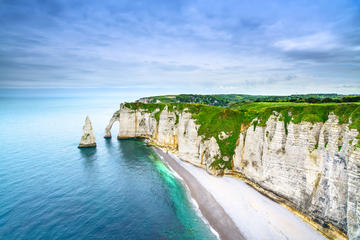
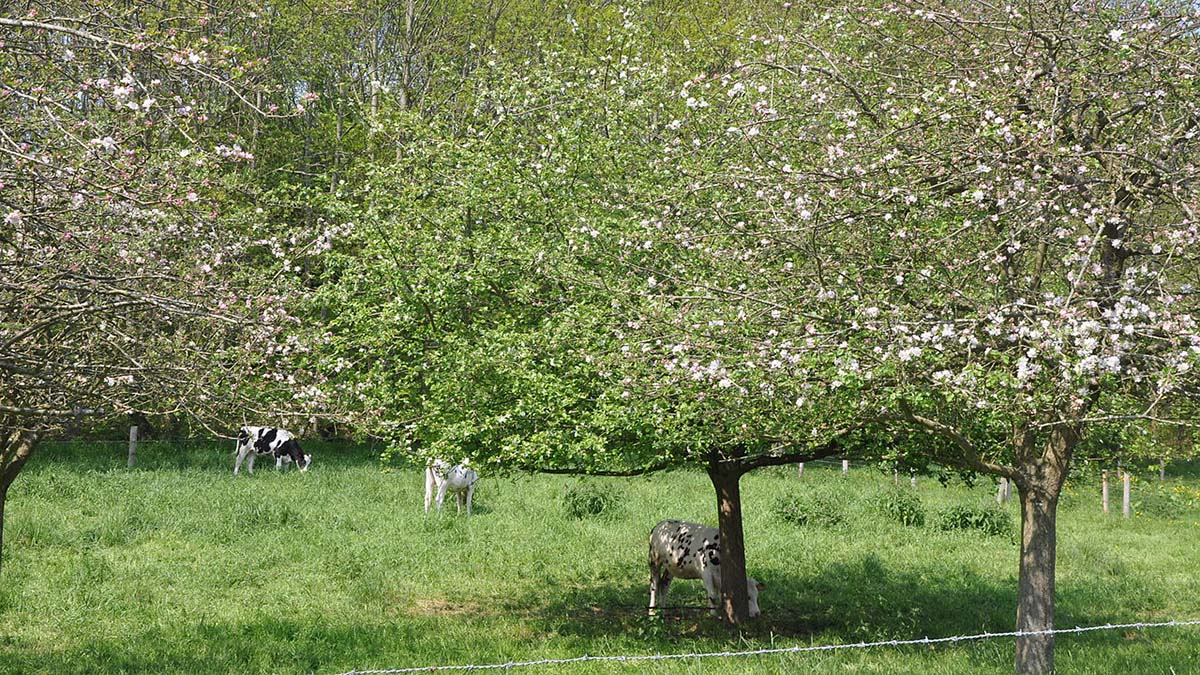
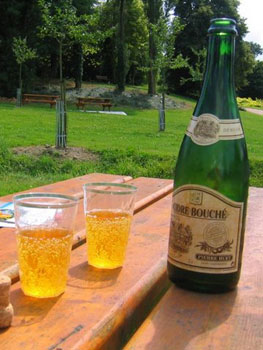 We headed for this scenic route, officially inaugurated on 25 May 1975, on a sunny day in July. It took us less than one hour, by taking the N13 from Caen, to reach the starting point of the Cider Route, Cambremer.
We headed for this scenic route, officially inaugurated on 25 May 1975, on a sunny day in July. It took us less than one hour, by taking the N13 from Caen, to reach the starting point of the Cider Route, Cambremer. Cider-makers on the Cider Route compete annually and those selected display the sign “Cru de Cambremer” on the roadside at the entrances to their farms. Nineteen producers have been awarded the “Cru de Cambremer” in 2010 and nine of them offer guided tours. The specified products of these “Cru de Cambremer” can be marketed under the label Cidre du Pays d’Auge (AOC), Cidre du Pays d’Auge Cambremer (AOC) or Calvados du Pays d’Auge (AOC).
Cider-makers on the Cider Route compete annually and those selected display the sign “Cru de Cambremer” on the roadside at the entrances to their farms. Nineteen producers have been awarded the “Cru de Cambremer” in 2010 and nine of them offer guided tours. The specified products of these “Cru de Cambremer” can be marketed under the label Cidre du Pays d’Auge (AOC), Cidre du Pays d’Auge Cambremer (AOC) or Calvados du Pays d’Auge (AOC).
 Our next stop was the distillery for making calvados – an apple brandy produced from cider by double distillation. The liquid, which was just 10% in volume of the pre-distilled cider, was kept in large oak barrels between three and 30 years to give different brands of calvados.
Our next stop was the distillery for making calvados – an apple brandy produced from cider by double distillation. The liquid, which was just 10% in volume of the pre-distilled cider, was kept in large oak barrels between three and 30 years to give different brands of calvados.